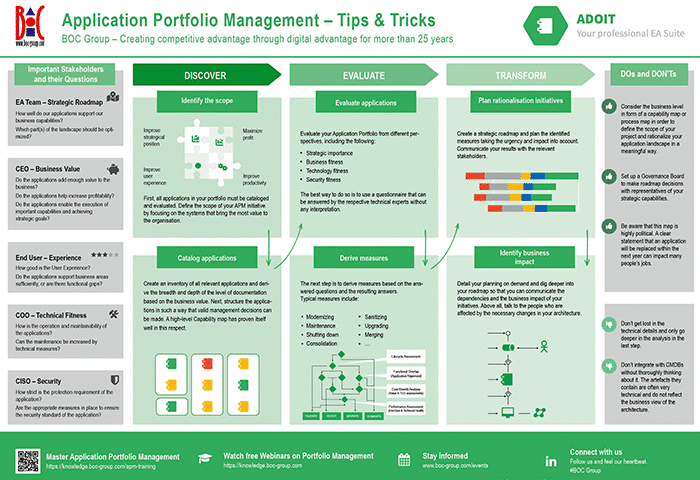Introduction
Have you ever wondered if your company is positioned well enough to face the future with confidence? Do you sometimes reflect on whether your organization is keeping pace with time, and is a successful player in its industry? Do you ever feel like your competition is outpacing you and your company is too passive to drive real innovation? Are the fast pace are complexity of today’s business world a sizeable challenge to your operations?
If your answer to any of these questions was yes, then be sure to read the following lines carefully and discover how a well-managed application landscape can be the key to your organization’s digital transformation. The following blog post reveals how you can create more room for digital innovation with the help of Application Portfolio Management (APM).

Why is Application Portfolio Management important?
In today’s world, information technology (IT) plays a central role in determining how well your business is poised for the future. Nowadays, virtually no transformation project takes places without, more or less, a major change to IT. Disruptive achievements in any industry are almost always based on novel technologies. That means: either new applications have to be introduced to optimally support the required process improvements, or existing applications have to be adapted.
Therefore, your company’s IT must primarily serve as an enabler rather than a blocker of such transformation initiatives. To this end, it is strongly advised that you create a “digital twin“ of your organization, to better plan and coordinate the impact of change on your enterprise architecture. This is why your applications (or apps), as well as the creation of a comprehensive and up-to-date application portfolio webinar play an integral role in this process. And for a good reason.

According to the latest statistics, more than two-thirds of all companies complain about having too many applications in their portfolio. In addition, the majority assumes that most of their applications generate little to no value for the organization (see Info-Tech Research Group). One reason behind such negative perceptions is the lack of a process for rationalization and harmonization of the company applications in use.
Due to complex architectural landscapes, IT today is primarily concerned with maintaining existing operational systems and keeping them running. Thus, it is becoming increasingly difficult to develop new strategies for the future and drive innovations from within the IT.
A guide to setting up your Application Portfolio Management efficiently
Streamlining of the application landscape helps to reduce costs and resource requirements across the IT, and therefore simultaneously creates more room for innovation. Minimizing the complexity and, as a result, the overall risk of the portfolio is what in the end drives the transformation of your company.
In order to declutter your application landscape, your applications must first be measured and assessed on the basis of various dimensions – like their business value contribution, technical fitness or compliance conformity. Based on this assessment, you can decide whether to further invest in such applications, replace them, consolidate them with others, or simply tolerate them. Gartner describes these different investment strategies as the T(olerate)-I(nvest)-M(igrate)-E(liminate) model (see Gartner’s Application Portfolio Management: TIME for the Application Masses).
- Tolerate
- Invest
- Migrate
- Eliminate
If you create an overview of the applications and their assignment to the respective investment strategies, application roadmaps can then be defined which will help the business units reflect on their needs and requirements, as well as optimize or even fundamentally transform the business processes they support.
The applications of your organizations therefore play a decisive role, and represent a starting point of many transformation initiatives. In order to effectively transform your application landscape, you must first gain an extensive understanding of it and collect this knowledge centrally. A neatly documented application portfolio (see our application portfolio e-learning) promises to be of great help here and describes the set of already existing and planned applications.
It is advisable to not only maintain this portfolio in the form of a list, but also collaboratively document it in an enterprise architecture tool so that this information can be maintained quickly and viewed at any time. This way, the so-called “shadow ITs” can be easily uncovered, functional and data redundancies investigated, and responsibilities and concrete lifecycle data properly captured.

Summary
As you can see, building an application portfolio is a powerful driver for the transformation and innovation of your enterprise. Being part of your digital twin, the portfolio can help you gain a competitive edge over your rivals. Setting up such an application portfolio can be done in small steps, and the first results can be already achieved with little effort.
In our free APM poster, you will find a summary of actionable insights and essential tips on setting up a solid application portfolio. And what’s more, we have also included a selection of other related content surrounding APM to help you leverage its full potential in driving your transformation forward. Download our poster to start with your APM initiatives today!
Top Related Content
Get our weekly updates.
Never miss the freshest content.









